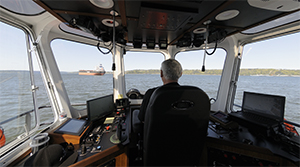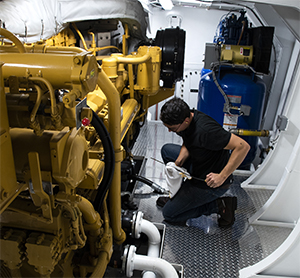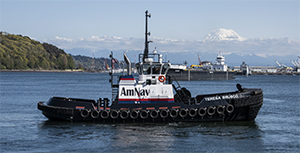Brusco Tug & Barge has taken delivery of another in a long line of Robert Allan-designed ship-docking tugboats. And like its sister tug Sarah, Teresa Brusco works under charter with AmNav Maritime of San Francisco.
AmNav won a recent contract docking containerships in Tacoma, Wash. The compact Teresa Brusco helped launch service, working Blair Waterway’s tight confines roughly 25 miles south of Seattle.
Diversified Marine of Portland, Ore., built the 78.1-by-30.4-foot Teresa Brusco. Delivery was in late 2017.
 |
|
Brusco’s latest tugs have Markey DEPC-48 electric winches on the bow. |
Brusco Tug of Longview, Wash., has seven ASD tugboats built to the Robert Allan Ltd. “Cates” design — an early precursor to the RApport series. These dayboats have a low freeboard, flush deck and small deckhouse. The first was delivered in 2001, followed by a second vessel four years later. The building program resumed in 2012, adding five more identical tugs to Brusco’s fleet.
All seven are powered by Caterpillar 3512-series engines. The last three boats, Bo Brusco, Sarah and Teresa Brusco, have 4,750 hp at 1,600 rpm. Teresa Brusco’s engines turn Rolls-Royce US 205 z-drives with fixed-pitch props through Centa carbon fiber shafts. Bollard pull exceeds 60 long tons.
Teresa and its siblings have twice the installed horsepower of the original tug prototype built in 1990 for the Cates company of Vancouver, B.C. The 73.5-by-28-foot Cates III was fitted with twin Caterpillar 3512 engines each producing 1,175 hp turning Niigata Z-Pellers. “This was our first tug with the larger-radius bow, and can very rightly lay claim to being the first anywhere with a very compact, one-man wheelhouse,” Allan recalled.
 |
|
One feature of the Cates design is the one-man wheelhouse. |
His design continued to evolve in the 1990s as Caterpillar 3512 engines grew more powerful. By 2000, the beam increased from 28 feet to 31 feet, 4 inches to handle 1,800-hp Cat engines. Propulsion came from Ulstein z-drives producing 50 tons of bollard pull.
The Cates concept eventually produced four design options comprising Robert Allan Ltd.’s RApport series. Allan describes them as “ideal for fast maneuvering, side-slip and quick response in tight conditions.” That certainly includes the conditions in Port Hueneme, north of Los Angeles, where the first two Brusco tugs were assigned.
This was the first of several West Coast contracts Brusco won. Brusco has based its five 78-foot RApport-series tugs in Port Hueneme, Portland, Ore., and Grays Harbor and Everett, Wash., alongside a few straight-shaft boats.
 |
|
Twin Caterpillar 3512 mains are capable of 4,750 total hp. |
Brusco’s first ASD tug, Wynema Spirit, was purpose-built for Port Hueneme, where it was joined by Lulapin in 2005. Capt. Mike Fullilove, now Brusco’s manager of operations, remembers the crew’s satisfaction with the new design.
“We handle U.S. Navy ships, tankers, fruit ships, containerships and car carriers up to 230 meters in length with very little room to spare,” he said. “They enter the port by a narrow channel and have to be turned in a 1,000-foot basin.”
These tugs had an established reputation by the time the sixth boat, Sarah, launched in 2015 and later went to work for AmNav in San Francisco Bay. Based on that successful partnership, AmNav chartered Teresa Brusco for Tacoma.
AmNav President Milt Merritt recalled looking to charter another compact ASD tug with high bollard pull after winning the Tacoma ship-docking contract.
 |
|
Engineer Nick Fuller checks fluids in Teresa Brusco’s all-Cat engine room. |
AmNav has operated four similar Robert Allan Ltd. vessels for many years. They were part of the 10-boat program for 80-foot Dolphin-class tugs built at Foss Shipyard in Rainier, Ore., in the early 2000s. “We really like all our Robert Allan-designed tugs, they work great in the other ports we operate in Los Angeles, Long Beach, San Francisco and Oakland,” said Capt. Brad Westlund, AmNav’s new port manager.
Teresa Brusco received fresh paint in AmNav’s colors of red, white and blue in April, shortly after arriving in Puget Sound. Despite the livery, the slanted staple on the foredeck continues to distinguish the Brusco boats. David Brusco and the crew in Port Hueneme developed it in 2001. He is now a Puget Sound Pilot and recently piloted a ship assisted by Teresa Brusco.
Back then, Brusco crews noticed the standard vertical staple on Wynema Spirit came close to the hull of ships with overhang aft and extreme flare forward. A local metal shop fabricated the slanted prototype angled aft at 37 degrees.
 |
|
Teresa Brusco’s hull is protected by Schuyler and Shibata fendering. |
This change moved the top of the staple back, allowing plenty of clearance. It was incorporated into the design for the next six boats. The bow is surrounded by a semicircle of Shibata cylindrical rubber, with Schuyler Companies’ double-loop fendering covering the rest of the bow down to the waterline.
Another small change came more recently. The accommodations on the first five boats provided a head, small galley and dinette booth. Diversified Marine outfitted the last two tugs with a double bunk next to the galley, which reduces seating space but provides space for crew to relax during downtime.
Teresa is also the first of Brusco’s fleet to feature two Caterpillar C4.4 ACERT 99-kW gensets for a 100-percent Cat engine room. These units supply the hotel loads and power a pair of Quincy air compressors, Rolls-Royce steering motors, the Markey hawser winch and other equipment. One genset connects to a Darley fire pump with 1,000 gallons per minute for an optional fire monitor.
“The new C4.4 ACERT shares the same design strategy with the C7.1 ACERT and was engineered to incorporate an 18 percent increase in power density, compared to the mechanical C4.4 platform,” noted Seth Charna, a Caterpillar Marine product champion.
 |
|
Teresa Brusco’s crew during a recent voyage in Commencement Bay off Tacoma, Wash., were, from left, James Edmonds, Nick Fuller and Grant Fuller. |
A common feature of Brusco’s engine room is the location of all coolant and bilge pumping valves on the centerline under the engine room ladder. This simplifies the movement of bilge or ballast water and procedures during emergencies.
Brusco’s latest tugs have Markey DEPC-48, 50-hp, single-drum electric hawser winches with Render/Recover. The drum can hold 600 feet of 2-5/8-inch Samson Saturn-12 line and has a rated performance of 28,000 pounds at 54 feet per minute. It also features automatic tension control. The air-set brake can hold 612,900 pounds.
Diversified Marine is located on the south bank of the Columbia River’s South Channel, 100 miles from the Pacific Ocean. Yard founder and manager Kurt Redd credits his team of experienced and dedicated employees for the high quality of their work. He believes this keeps a steady flow of repeat orders coming from established operators such as Harley Marine, Brusco Tug and Shaver Transportation.

